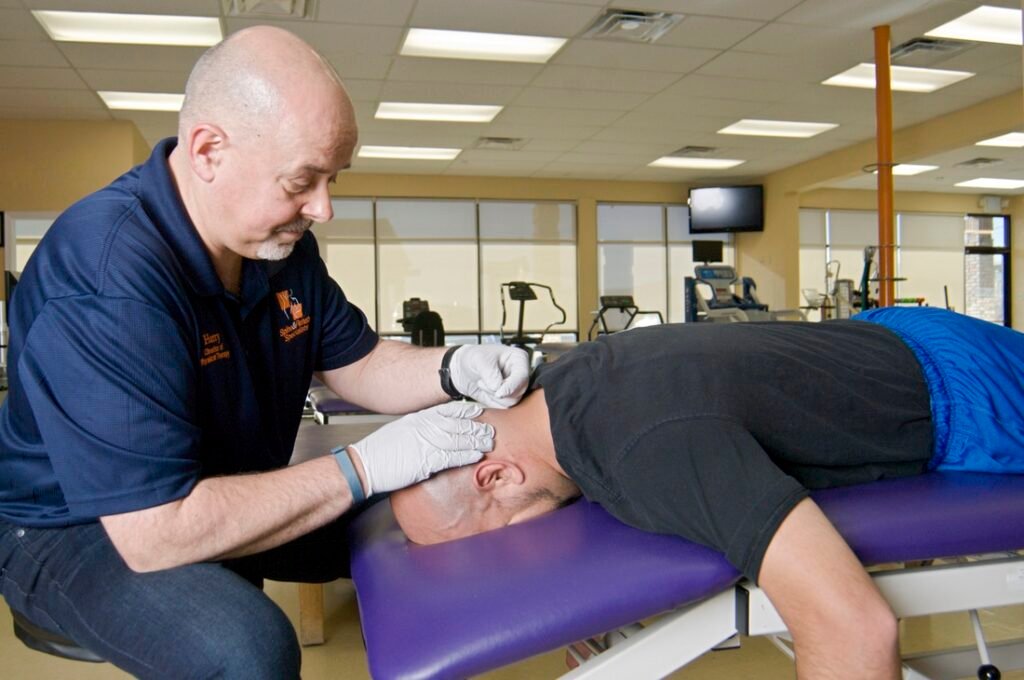Hip and gluteal pain can significantly impact daily activities, from walking to sitting comfortably. While traditional treatments followed, has emerged as a practical approach. Dry needling’s benefits for hip and gluteal pain enhance overall mobility.
The Fundamentals of Dry Needling Therapy
Dry needling therapy involves inserting fine, sterile needles into specific muscle areas to reduce pain and release tension. Intramuscular Stimulation (IMS) uses modern anatomical and neurophysiological principles to target trigger points, alleviate muscle tightness, and enhance overall muscle function. Trigger points, caused by muscle overuse, stress, or injury, create localized pain and tightness. Dry needling addresses these points to restore normal muscle function and relieve discomfort.
Applications of Dry Needling
Dry needling helps to treat a variety of conditions, including:
- Chronic Pain: It involves conditions like fibromyalgia, lower back pain, and neck pain, often involving muscle tightness and trigger points, making them ideal candidates for dry needling.
- Sports Injuries: Athletes frequently use dry needling to relieve muscle tightness, enhance performance, and speed up injury recovery.
- Postural Problems: Poor posture leads to muscle imbalances and tightness, which dry needling can help address.
- Rehabilitation: Patients recovering from surgeries or injuries may benefit from dry needling as part of their overall rehabilitation program to restore muscle function and reduce pain.
How Dry Needling Relieves Hip And Gluteal Pain: Benefits Explained
Dry needling helps alleviate pain and restore function in hip and gluteal pain. Dry needling in Edmonton offers numerous benefits by targeting the root causes of discomfort.
Targeted Pain Relief
Dry needling provides precise, targeted pain relief. Hip and gluteal pain often originates from tight or overactive muscles, such as the hip flexors, piriformis, and gluteal muscles. These muscles can develop trigger points—tiny muscle knots that can cause pain and discomfort. In dry needling, needles get inserted into these trigger points. This process disrupts the pain cycle, reducing localized pain and providing relief where it’s needed most.
Reduction of Muscle Tightness and Spasms
Muscle tightness and spasms are common causes of hip and gluteal pain. These conditions can limit mobility, cause discomfort, and lead to further muscle imbalances. Dry needling helps by inactivating the trigger points within the muscles, which are the primary sources of tightness and spasms. By targeting these specific areas, dry needling relaxes the muscles, reduces spasms, and restores normal muscle function. It can lead to an improvement in range of motion and a decrease in pain during daily activities. After the dry needling treatment, patients are often encouraged to perform gentle hip and gluteal stretches, such as the piriformis or hip flexor. These exercises help elongate the muscles, maintain flexibility, and prevent spasms.
Enhanced Blood Circulation
Improved blood circulation is another critical benefit of dry needling. Dry needling helps to stimulate blood flow to the affected areas. This circulation helps deliver essential nutrients to the muscles and reduces inflammation. For individuals suffering from chronic hip and gluteal pain, this enhanced blood flow can accelerate recovery and decrease the frequency of pain episodes.
Improved Mobility and Flexibility
Tight muscles can severely limit mobility and flexibility in the hip and gluteal regions, exacerbating pain and restricting movement. Dry needling physiotherapy addresses this issue by releasing the tight muscles, restoring flexibility and improving overall mobility. Patients find it easier to perform daily activities without experiencing pain. Post-needling, a series of dynamic stretches, such as leg swings or lunges, can be performed to promote flexibility and ensure that the muscles remain supple and responsive.
Facilitating Tissue Repair
In hip and gluteal pain, dry needling involves inserting needles into targeted muscle areas, stimulating the body’s natural healing processes. This technique activates fibroblasts, the cells responsible for producing collagen, a crucial component for repairing damaged muscle fibres and connective tissues. By inducing controlled micro-trauma to the affected muscles, dry needling encourages the body to initiate healing mechanisms, leading to faster recovery from injuries and strains in the hip and gluteal regions.
Reducing Inflammation
For hip and gluteal pain, dry needling effectively addresses trigger points and reduces muscle tension, which helps lower local inflammation. This reduction in inflammation alleviates pressure on surrounding tissues and nerves, leading to decreased pain and swelling. Dry needling enhances recovery and improves overall comfort in the affected areas by creating a more favourable environment for tissue repair.
Complementary to Other Physiotherapy Techniques
Dry needling is particularly effective when used alongside other physiotherapy techniques. Dry needling can complement therapeutic exercises, manual therapy, and stretching routines for hip and gluteal pain rehabilitation patients. This combined approach leads to faster recovery and more comprehensive pain relief. A typical rehabilitation program might combine dry needling, targeted strengthening exercises like clamshells or bridges, and manual therapy techniques to ensure a holistic recovery.
Long-Term Pain Management
Beyond immediate pain relief, dry needling therapy contributes to long-term pain management by addressing the root causes of muscle tightness and dysfunction. When integrated into a comprehensive regular treatment plan, dry needling sessions can prevent the recurrence of pain, leading to sustained improvements in the patient’s condition and overall quality of life.
Experience Relief with Dry Needling: Take the Next Step Toward Pain-Free Living
Dry needling in Edmonton provides numerous benefits for individuals experiencing hip and gluteal pain, offering targeted pain relief, improved mobility, and long-term management. Those seeking to address underlying muscle dysfunction can contact where dry needling is an effective solution for pain relief. Consulting with our qualified physiotherapist is recommended for individuals considering dry needling as part of their pain management strategy.

